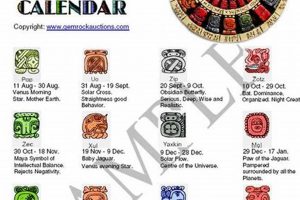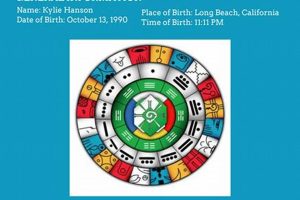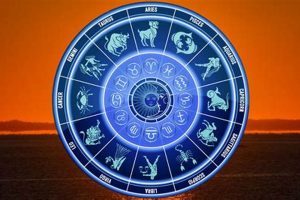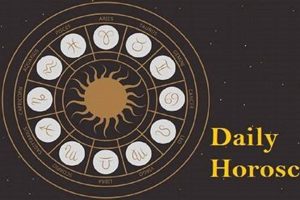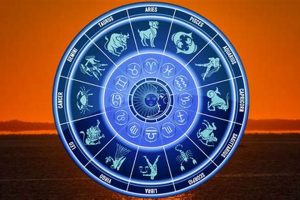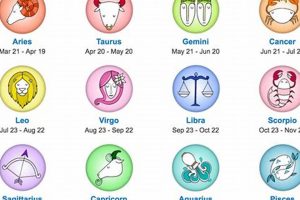This Mesoamerican system of divination uses a complex calendar system incorporating cycles like the 260-day Tzolkin and the 365-day Haab, alongside other longer cycles. These calendars interact to create unique combinations believed to influence individuals and events. A specific birth date, for instance, corresponds to particular energies and deities, offering insights into personality traits, life path, and destiny.
Offering a framework for understanding time and its influence on human existence, this ancient practice provides a lens through which individuals can gain self-awareness and navigate life’s challenges. Rooted in a rich cultural heritage, its continued practice reflects the enduring human desire to understand one’s place in the cosmos and connect with ancestral wisdom. This system represents a unique blend of astronomical observation, mathematical precision, and spiritual belief.
The following sections will delve deeper into the specific components of this intricate system, exploring the individual calendars, the significance of associated deities, and the practical application of its insights for personal growth and understanding.
Tips for Engaging with this Mesoamerican Divination System
These suggestions offer pathways to a deeper understanding of this complex system of timekeeping and divination.
Tip 1: Understand the Calendar System: Familiarization with the Tzolkin and Haab calendars, and how they interrelate, provides a foundational understanding crucial for interpreting its insights. Learning the day signs and their associated energies is essential.
Tip 2: Consult with a Practitioner: While self-study is valuable, consultation with an experienced practitioner offers personalized interpretations and guidance. They can provide insights based on specific birth dates and current astrological transits.
Tip 3: Explore Associated Deities: Each day sign and calendar cycle aligns with specific deities. Researching these deities and their attributes enriches comprehension of the energies influencing a given time period.
Tip 4: Reflect on Personal Experiences: Connect insights derived from this practice with personal experiences. Reflection allows for a deeper integration of the wisdom offered and facilitates self-discovery.
Tip 5: Use it as a Tool for Self-Development: The insights gleaned from this system offer opportunities for personal growth and navigating life’s challenges with greater awareness. It encourages mindful engagement with time’s cyclical nature.
Tip 6: Respect its Cultural Origins: This practice is rooted in a rich cultural heritage. Engaging with respect and appreciation for its origins is vital for meaningful understanding.
By incorporating these suggestions, individuals can gain a deeper appreciation and understanding of this ancient practice and its potential for personal growth and insight.
The following concluding remarks offer a final perspective on the significance and enduring legacy of this fascinating system.
1. Tzolkin Calendar
The Tzolkin calendar, a 260-day sacred cycle, forms a cornerstone of this Mesoamerican system. Comprising 20 day signs and 13 numbers, it generates unique combinations that influence daily energies and individual destinies. This calendar’s significance stems from its perceived ability to reveal inherent personality traits, life purpose, and auspicious timing. Its influence permeates all aspects of this divinatory practice, providing the foundational structure upon which other calendrical cycles are built.
For example, a birth date of 1 Imix imbues an individual with the pioneering and creative energies associated with the Imix day sign, tempered by the initiating force of the number 1. This combination influences personality and potential life path. The Tzolkin’s interaction with the 365-day Haab calendar creates the Calendar Round, a larger cycle revealing more nuanced interpretations of individual destinies and historical events. This interplay highlights the intricate nature of this system and its multifaceted approach to timekeeping and divination.
Understanding the Tzolkin calendar is crucial for interpreting this broader divinatory practice. It reveals the cyclical nature of energy and its influence on human experience. Recognizing the influence of the Tzolkin deepens one’s understanding of individual destinies and the interconnectedness of time and human existence. The Tzolkin’s continued relevance in contemporary practice demonstrates its enduring power and the profound impact it continues to have on those who engage with its wisdom. Further exploration of its intricate structure and associated symbolism reveals the depth and complexity of this ancient system.
2. Haab Calendar
The Haab calendar, a 365-day solar calendar, plays a crucial role in this Mesoamerican system. While the Tzolkin calendar governs sacred cycles, the Haab anchors timekeeping in the observable solar year, providing a practical framework for agricultural and societal rhythms. Its 18 months of 20 days each, plus a five-day period known as Wayeb, reflect a close observation of the Earth’s annual journey around the sun. The Haab’s interplay with the Tzolkin creates the Calendar Round, a complex cycle fundamental to this divinatory practice.
- Agricultural Significance
The Haab’s alignment with the solar year facilitated agricultural planning and seasonal celebrations. The timing of planting, harvesting, and specific rituals revolved around the Haab’s cycle. For instance, specific ceremonies corresponded with the zenithal passages of the sun, demonstrating the practical integration of astronomical observation and daily life.
- Wayeb’ Period
The five-day Wayeb period held unique significance, considered a time of transition and reflection. Associated with liminal energies and potential misfortune, it marked a period of introspection before the beginning of a new Haab cycle. This period emphasizes the cyclical nature of time within this system.
- Month Names and Glyphs
Each of the 18 months carries a unique name and associated glyph, reflecting specific seasonal attributes and symbolic meanings. These names, such as Pop, Zip, and Zotz, offer insights into the prevailing energies during those periods. For example, Pop signifies the mat, symbolic of leadership and community, while Zip connects to the deer and hunting.
- Interaction with the Tzolkin
The Haab calendar, when combined with the Tzolkin, creates the 52-year Calendar Round, a significant cycle marking a complete integration of sacred and solar time. This interplay produces unique combinations of day signs and month names, offering complex divinatory insights. Specific dates within the Calendar Round hold distinct energies and associations, informing individual destiny and historical interpretation.
The Haab calendar, though seemingly a practical tool for tracking the solar year, plays a crucial role in enriching the divinatory aspects of this Mesoamerican system. Its interaction with the Tzolkin creates the complex interwoven cycles that underpin this practice, offering a multifaceted understanding of time and its influence on human existence. The Haab, by grounding the cyclical nature of the Tzolkin within a tangible solar year, adds depth and nuance to interpretations and predictions, highlighting the interconnectedness of celestial movements and earthly events.
3. Calendar Rounds
Calendar Rounds form a cornerstone of this Mesoamerican system, representing the cyclical interplay between the 260-day Tzolkin and the 365-day Haab calendars. This 52-year cycle, arising from the least common multiple of the two calendar lengths, signifies a complete integration of sacred and solar time. Each day within a Calendar Round possesses a unique combination of Tzolkin and Haab day signs, imbued with specific energies and associations. This intricate interplay provides a framework for understanding individual destinies, historical events, and the cyclical nature of time itself. The Calendar Round’s significance lies in its ability to offer a nuanced perspective on recurring patterns and their influence on human experience.
For instance, a birth date corresponding to 1 Imix in the Tzolkin and 8 Pop in the Haab would not recur for another 52 years. This unique combination links an individual to particular deities, energies, and life path predictions. Similarly, historical events were recorded and interpreted within the context of specific Calendar Rounds, providing a framework for understanding recurring patterns and drawing parallels between past and present. The Calendar Round thus serves as a crucial tool for divination, allowing practitioners to anticipate potential challenges and opportunities based on the recurring energies associated with specific dates.
Understanding Calendar Rounds provides essential context for interpreting this divinatory practice. This intricate interplay of cyclical time reveals a sophisticated understanding of the cosmos and its influence on human affairs. Recognizing the significance of Calendar Rounds allows for deeper insights into individual destinies and the recurring patterns that shape historical and personal narratives. This concept reinforces the cyclical nature of time emphasized within this Mesoamerican system and provides a practical framework for applying its wisdom to contemporary life. Challenges in understanding Calendar Rounds often arise from the complexity of the two interacting calendars. However, grasping this core principle unlocks a deeper appreciation for the sophistication and depth of this ancient practice.
4. Day Signs (Glyphs)
Day signs, represented by glyphs, function as fundamental building blocks within this Mesoamerican system. Each of the 20 day signs embodies unique energies and characteristics, influencing the qualities associated with specific dates within the Tzolkin calendar. These glyphs, far from mere symbols, represent complex concepts and deities, offering a rich tapestry of symbolic meaning. Their influence extends beyond simple daily energies, shaping individual destinies, informing ritual practices, and providing a framework for understanding the cyclical nature of time. The specific sequence and combination of day signs within the Tzolkin calendar generate a complex interplay of energies, impacting interpretations and predictions.
For example, the day sign Imix, represented by a glyph resembling a water lily, symbolizes beginnings, nourishment, and potential. Individuals born on an Imix day are often considered to possess innate creative energies and a strong connection to the natural world. Conversely, the day sign Ahau, depicted as a lord or ruler, embodies leadership, authority, and completion. Understanding the distinct characteristics of each day sign provides essential insights into the energies influencing a particular date and their impact on individuals born under its influence. These glyphs, therefore, act as a key for unlocking the deeper meaning embedded within the Tzolkin calendar and its broader divinatory application. The combination of a day sign with its corresponding number in the Tzolkin further refines the interpretation, creating a nuanced understanding of individual destinies and life paths. For instance, 1 Imix carries a different energetic signature than 7 Imix, reflecting the added influence of the numerical coefficient.
Day signs, as represented by their glyphs, constitute an essential component of this Mesoamerican system. Their symbolic meanings and energetic associations provide a framework for interpreting the Tzolkin calendar and understanding its influence on individual destinies and cyclical time. Grasping the significance of each day sign enriches one’s appreciation for the complexity and depth of this ancient practice. Challenges in understanding day signs often arise from the intricate web of symbolic associations and their interplay within the broader calendrical system. However, a focused study of these glyphs and their associated meanings unlocks valuable insights into the rich tapestry of this Mesoamerican tradition and its enduring legacy.
5. Associated Deities
Deities play an integral role in this Mesoamerican system, embodying the energies and characteristics associated with specific day signs and time periods. Each deity possesses unique attributes and domains of influence, informing interpretations of individual destinies and cyclical events. Understanding the roles and symbolism of these deities provides essential context for navigating the complexities of this divinatory practice. Their presence adds a layer of spiritual significance, connecting individual experiences to the broader cosmological framework of belief.
- Patron Deities of Day Signs
Each of the 20 day signs within the Tzolkin calendar aligns with a specific patron deity. These deities embody the core energies and characteristics associated with their respective day signs. For example, the deity Itzamn, associated with the day sign Imix, represents creation, knowledge, and healing. Individuals born on an Imix day are believed to share these attributes, connecting them to Itzamn’s influence. Understanding these patron deities provides deeper insight into the energies shaping individual destinies.
- Deities Associated with Time Periods
Specific deities govern particular time periods within the Haab calendar and larger cycles like the Calendar Round. These deities exert influence over the prevailing energies during these periods, impacting agricultural cycles, ritual practices, and interpretations of historical events. For instance, the deity Chac, associated with rain and agriculture, holds particular significance during specific months of the Haab calendar, reflecting the importance of rainfall for successful harvests. Recognizing these temporal associations enhances understanding of the cyclical nature of time and its divine governance.
- Deities and Ritual Practice
Deities played a central role in ritual practices designed to honor specific energies and seek divine guidance. Offerings, prayers, and ceremonies were directed toward particular deities based on the relevant day sign or time period. These practices aimed to establish a harmonious relationship with the divine forces governing the cosmos. For example, rituals dedicated to the maize god, associated with sustenance and abundance, were performed during planting and harvesting seasons to ensure successful crops. This ritual context demonstrates the practical integration of deity worship into daily life.
- Symbolism and Iconography
Deities are often depicted with specific symbols and iconographic elements that further convey their attributes and domains of influence. These symbols, embedded within carvings, codices, and other forms of artistic expression, provide valuable clues for understanding the complex interplay of divine forces within this cosmology. For instance, the serpent imagery associated with Itzamn symbolizes transformation and renewal, reflecting the deity’s connection to creation and healing. Analyzing these symbolic representations deepens comprehension of the deities’ multifaceted roles and their influence within this system.
The association of deities with specific day signs, time periods, and ritual practices adds a layer of spiritual depth to this divinatory framework. Understanding the roles and symbolism of these deities provides a crucial key for unlocking the rich tapestry of meaning embedded within this system. By connecting individual destinies and cyclical events to the broader cosmological narrative, the deities provide a powerful lens through which to interpret the complexities of time, fate, and human existence. This intricate interplay between deities and calendrical cycles reinforces the holistic nature of this practice, highlighting the interconnectedness of the spiritual and material realms.
6. Divination & Cycles
Divination within this Mesoamerican system relies heavily on the intricate interplay of its various cycles. The Tzolkin, Haab, and Calendar Round, each operating on different timescales, combine to create a complex matrix of energies believed to influence individual destinies and the unfolding of events. Divination practices leverage these cyclical patterns to gain insights into personality traits, predict auspicious timing for various endeavors, and understand the recurring themes shaping individual lives. This cyclical framework provides a structured approach to interpreting the perceived influence of time on human experience. For example, specific combinations of Tzolkin and Haab day signs within a Calendar Round are believed to indicate favorable periods for marriage, planting, or undertaking journeys. These cycles offer a framework for decision-making, aligning actions with perceived auspicious energies.
The cyclical nature of time, as understood in this system, suggests that certain energies and patterns recur over time. Divination aims to decipher these recurring influences, enabling individuals to anticipate potential challenges and opportunities. By understanding the energetic qualities associated with specific time periods, practitioners seek to harmonize their actions with the prevailing cosmic influences. This understanding of cyclical recurrence is central to the practical application of this divinatory system. For example, knowing that certain periods are associated with heightened emotional intensity or increased potential for conflict allows individuals to approach those times with greater awareness and prepare accordingly. Divination, therefore, becomes a tool for navigating life’s complexities with greater foresight and understanding.
The interplay between divination and cyclical time forms a core principle within this Mesoamerican system. By understanding the intricate patterns woven by the various calendars, individuals can gain valuable insights into their personal destinies and the recurring themes shaping their lives. While the complexity of these cycles may present challenges to comprehension, grasping their significance provides a deeper appreciation for the sophistication and depth of this ancient practice. This approach to divination emphasizes the interconnectedness of time and human experience, offering a unique perspective on the cyclical nature of fate and the potential for individual agency within a larger cosmic framework.
Frequently Asked Questions
This section addresses common inquiries regarding this Mesoamerican system, offering concise and informative responses.
Question 1: How does this system differ from Western astrology?
This Mesoamerican system emphasizes cyclical time and the interconnectedness of natural and cosmic events, employing a distinct calendar system unrelated to the zodiac. Western astrology, based on the constellations and planetary movements within a solar year, focuses on individual personality and forecasting.
Question 2: What is the significance of the Calendar Round?
The Calendar Round represents the synchronization of the 260-day Tzolkin and 365-day Haab calendars. This 52-year cycle provides a framework for understanding recurring patterns and their influence on individual lives and historical events.
Question 3: How can one determine their day sign?
Determining one’s day sign requires knowing their birth date and consulting conversion tools or resources based on this Mesoamerican calendar system. These resources can correlate Gregorian calendar dates with corresponding Tzolkin and Haab day signs.
Question 4: Is it possible to learn and interpret this system independently?
While self-study is possible, consulting experienced practitioners offers valuable guidance and personalized interpretations. Given the systems complexity, expert guidance can significantly enhance comprehension and application.
Question 5: How does this system apply to contemporary life?
This system provides a framework for self-reflection, understanding personal energies, and navigating life’s cyclical patterns. Its insights can promote self-awareness and informed decision-making, offering a unique perspective on personal growth.
Question 6: What resources are available for further exploration?
Numerous books, websites, and workshops explore this system in greater detail. Seeking reputable sources and experienced practitioners ensures accurate information and respectful engagement with this rich cultural heritage.
Understanding the core principles of this system, including its unique calendar system and the significance of day signs and deities, provides a foundation for further exploration. Continuous learning and engagement with reputable resources deepen one’s appreciation for this rich tradition.
Further exploration of this topic might delve into the historical context of this Mesoamerican system, its evolution over time, and its enduring legacy in contemporary practices.
Conclusion
This exploration has revealed a complex system of timekeeping and divination deeply intertwined with Mesoamerican cosmology and culture. The intricate interplay of the Tzolkin and Haab calendars, the significance of day signs and associated deities, and the cyclical nature of time all contribute to a rich framework for understanding individual destinies and the recurring patterns of human experience. This system offers not merely a method of prediction, but a profound philosophy that connects individuals to the cosmos and ancestral wisdom.
This ancient practice, far from a relic of the past, continues to resonate with those seeking deeper understanding of themselves and the universe. Its enduring legacy lies in its ability to provide a unique perspective on the cyclical nature of time, the interplay of cosmic forces, and the potential for human agency within a larger framework of destiny. Further research and exploration promise to unveil even greater depths within this complex and fascinating system, offering continued insights into the human quest for meaning and connection to the cosmos.


